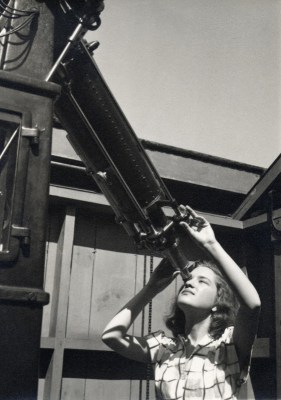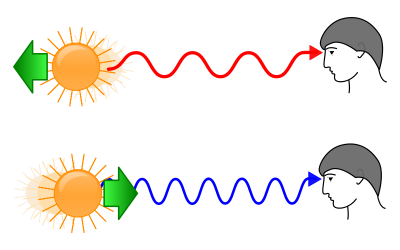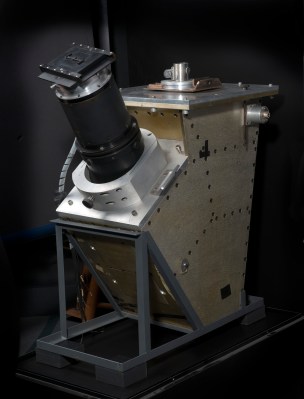Vera sat hunched in the alcove at Kitt Peak observatory, poring over punch cards. The data was the same as it had been at Lowell, at Palomar, and every other telescope she’d peered through in her feverish race to collect the orbital velocities of stars in Andromeda. Although the data was perfectly clear, the problem it posed was puzzling. If the stars at the edges of spiral galaxy were moving as fast as the ones in the center, but the pull of gravity was weaker, how did they keep from flying off? The only possible answer was that Andromeda contained some kind of unseen matter and this invisible stuff was keeping the galaxy together.
Though the idea seemed radical, it wasn’t an entirely new one. In 1933, Swiss astronomer Fritz Zwicky made an amazing discovery that was bound to bring him fame and fortune. While trying to calculate the total mass of the galaxies that make up the Coma Cluster, he found that the mass calculation based on galaxy speed was about ten times higher than the one based on total light output. With this data as proof, he proposed that much of the universe is made of something undetectable, but undeniably real. He dubbed it Dunkle Materie: Dark Matter.
But Zwicky was known to regularly bad mouth his colleagues and other astronomers in general. As a result, his wild theory was poorly received and subsequently shelved until the 1970s, when astronomer Vera Rubin made the same discovery using a high-powered spectrograph. Her findings seemed to provide solid evidence of the controversial theory Zwicky had offered forty years earlier.

To the Stars Through Difficulties
From a young age, Vera felt the invisible tug of the cosmos. When she was ten, her family moved from Philadelphia to Washington, DC. Windows lined one wall of her new bedroom, and she marveled at the stars beyond, captivated by their movement throughout the night.
At school, she took every opportunity to study the stars and even started an astronomy club with some of her classmates. Vera’s father took her to amateur astronomy meetings and helped her build a cardboard telescope, which she used to study the meteors streaking past her windows.
Vera’s parents supported her interest in astronomy, but her teachers were another story. During a college admissions interview, a Swarthmore counselor tried to steer her away from astronomy, suggesting that she paint cosmological objects instead, because art was a more ladylike pursuit. Gender discrimination was a battle she would fight all her life, both for herself and for future generations of starstruck little girls.
With Swarthmore out of the running, she applied to Vassar. Maria Mitchell had taught there, and Vera was inspired to attend an institution that valued women in science. Vera earned her bachelor’s degree in 1948 as that year’s only graduate of astronomy. The same year, she married Robert Rubin, a future physicist.

Redshift, Blueshift
Vera applied to several graduate schools including Princeton, who told her they didn’t accept women in their astronomy program. They wouldn’t even send her a course catalog. She eventually enrolled at Cornell, where Robert was a graduate student.
Soon, she became fascinated with the dynamics of galaxies. Her graduate work mainly focused on identifying heavenly bodies that deviated from the Hubble flow, which is the redshift-based observation of the motion of galaxies due to the expansion of the universe.
Redshift is simply the Doppler effect applied to light-emitting objects. When a fire truck goes wailing past our ears, the frequency of the siren is compressed before it reaches us, so the sound is higher-pitched. The moment it passes by, the sound wave expands, and the pitch goes lower and lower until it’s out of earshot. This shift in frequency is the Doppler effect.
The visible light spectrum does the same trick: distant galaxies moving away from us shift toward the red end of the spectrum, and those moving toward us shift the opposite way, toward the blue end. By measuring redshift, scientists can measure the speeds of galaxies and other objects in deep space.

As the Galaxy Turns
Vera graduated Cornell in 1951 and entered the PhD program at Georgetown about six months later. Her doctoral adviser was George Gamow, an early architect of the Big Bang theory. Here, the gender bias was a real bulldog. Women were simply not allowed in the area of the university that housed Gamow’s office, so Vera took all of her meetings with him the wood-paneled library of the nearby Carnegie Institute.
Vera was still moved by galaxy dynamics. She decided to focus her dissertation on the theory that galaxies clump together rather than being randomly distributed throughout the universe. Another adviser said her paper was good enough to be presented at the next meeting of the American Astronomical Society (AAS)—by him. She said no, she could do it herself.
So with her baby in tow and another due in a few weeks, Vera drove to Pennsylvania through a snowstorm to deliver her talk, titled “Rotation of the Universe”. She didn’t know anyone at the meeting and considered herself a fraud among these ‘professional’ astronomers. Their reaction to her paper was a mostly negative discussion of her ideas, and the experience didn’t do much for Vera’s confidence. Her controversial theory would go unexplored for two decades.

Clocking the Speeds of Stars
For the next eleven years Vera taught math, physics, and astronomy at Georgetown while raising four children. All four eventually became natural science or math PhDs, mostly because Mom always made science look fun.
In 1965 Vera left Georgetown to ask for a job at the Carnegie Institute’s Department of Terrestrial Magnetism (DTM). There was no application to fill out or interview process to sweat through. Instead, she was handed a 2″ x 2″ glass photographic plate containing the spectrum of a star. If she could measure its velocity, she could have the job. She got the job.
At DTM she was introduced to W. Kent Ford, an astronomer and instrument maker who became her lifelong research partner. It was a match made in heaven. Kent had just built an advanced spectrograph, a device that fractures light into its constituent wavelengths. It was lined with the latest in photomultipliers and several times more sensitive than anything else available.
Kent’s spectrograph was the kind of technology that would allow astronomers to examine specific regions of a galaxy instead of taking it at face value. He was eager to test the device’s limitations, and Vera was excited to make the types of observations that might prove her galactic rotation theories.
Analyzing Andromeda
Around this same time, Vera was accepted to Palomar Observatory in California. Palomar had been previously closed to women, so the only restrooms were technically mens’ rooms. Vera took care of that problem in short order. She cut a little skirt out of paper and taped it over the signage of one restroom, claiming it for the ladies.
Vera usually faced gender bias with a combination of humor and straightforwardness, but after the rough treatment at the AAS meeting, she wanted to avoid controversy. Her plan for Palomar was to stay away from hot new topics like quasars and other heavily trod areas. Instead, she decided to aim Kent Ford’s amazing spectrograph at the stars of our neighboring galaxy, Andromeda.

Andromeda is a spiral galaxy made of high concentration of stars swirling around in the center, and many other stars in the outer regions that loosely orbit the swirling cloud. Astronomers long believed that most of a galaxy’s mass was at the heavily populated center. To the naked eye, this seems perfectly reasonable. So does the idea that the stars at the fringe move more slowly than the ones at the center. That’s how our own solar system works, after all: out here on the third rock, it takes ~365 days to orbit the Sun, but Mercury can do it in 88.
If we could lay Andromeda on a table, crouch down, and look at it from the edge, we would see stars coming at us on one side and moving away on the other. With Kent’s spectrograph, Vera could measure the redshift of the stars in the middle with the stars on the outskirts and compare their orbital speeds.
Right away, she noticed that the stars on the outer edges of Andromeda were moving just as fast as the ones in the middle. It didn’t make sense. If they were moving at the same speed, they should just fly away since they’re untethered by the gravitational pull that keeps the center together. Some kind of gravitational matter must be keeping them in place.
Vera and Kent traveled all over the U.S. to different observatories and studied more than sixty regions of Andromeda. She would arrive a few days early and cut out dozens of 2″ x 2″ glass photographic plates in complete darkness, and then bake them for 72 hours to increase their sensitivity. On their scheduled nights, she and Kent took turns at the telescope guiding each star carefully along the guide lines. Then Vera developed the plates and analyzed them with the spectrograph.
They studied other spiral galaxies and always came up with the same data. Vera reasoned that there had to be some kind of invisible matter there with enough gravity to keep it from disintegrating. According to her calculations, there had to be about ten times as much invisible matter as visible matter. The mystery reminded her of Fritz Zwicky’s Dunkle Materie, which she’d learned about in graduate school. Her data seemed to definitively confirm Zwicky’s theory that the universe is mostly made up of unseen matter.
At first, she faced nearly as much disbelief from the scientific community as he had. But the data spoke for itself. There was no denying the presence of some invisible cosmic glue tying the galaxy together. Over time, Vera’s findings would be strengthened by the discovery of the cosmic microwave background and gravitational lensing.
The Real Prize
Vera paved the way for women in astronomy, but she saw scientific inquiry as a human endeavor and argued that we all have equal permission to do science. She was a strong advocate of scientific literacy for everyone from schoolchildren to senators. The fact that she juggled a family and an astronomy career has been an inspiration to women, particularly astrophysicist Sandra Faber.
Vera received several honors throughout her career, including a National Medal of Science and a Gold Medal of the Royal Astronomical Society, but she never won a Nobel Prize. Though she arguably deserved one, it may not have mattered to her because she wasn’t after fame and fortune. To her, “the real prize is finding something new out there.”
Vera died December 25th, 2016 of dementia-related complications. She was 88 years old.















This was the first I’ve read of how “Dark Matter” was deemed to exist.
I’ve read statements like “Astronomers believe Dark Matter and Dark Energy make up (huge percentage) of the Universe.”
or,
“(certain astrophysical phenomena) can only be explained by the presence of Dark Matter/Energy”.
Such statements did not say why they believe DM/E exists, or explain the observed phenomena in sufficient detail.
Thank you.
Even worse are the numbing and endless sensational articles which seem to treat dark matter / energy as some kind of end result; a murky, spooky, eldritch substance from the mirror dimension instead of a placeholder term that astronomers use to explain discrepancies in measurement until they figure out what’s really happening. Science journalists latch on to the mysterious and ominous connotation of “dark” instead of the simple, intended meaning: “doesn’t emit light.”
Thanks, everyone, for writing up a great article with the details and crediting this woman for her hard work in the field!
“as some kind of end result; a murky, spooky, eldritch substance from the mirror dimension”
The problem with this is… well… that’s basically what it’s ending up as. In the beginning, when Rubin found it in galaxy rotation curves, it could’ve been completely normal matter, just somehow not glowing. You could’ve even gone crazy and said there was some big population of black holes that forms eventually that dominate the dynamics but have depleted everything around them to accrete. Or hell, just bucketloads of brown dwarfs or something.
But subsequent studies have basically ruled out *all* of that, and the microwave background results make it pretty conclusive: whatever dark matter is, it isn’t made out of the same stuff as normal stars are. ‘Dark matter’ started out as meaning “doesn’t emit light,” but it basically does mean some physics sector that we completely don’t understand nowadays.
I long ago came to the conclusion journalists don’t know jack and just poorly summarize everything. Look at an article on something you’re an expert on, notice the number of errors. Now look at one you’re not an expert on. What makes you think there are any less?
This is why it’s important we have people like Neil deGrasse Tyson, and Brian Cox. They’re educated in the fields they’re talking about, and they know how to explain the concepts more broadly to the general population.
Maybe HackaDay should make a new “Category” and “tag” to group these articles about forgotten or little known scientists/engineers to enable quicker Searches.
That’s a really good idea. We actually *have* something for this that might be better. We have a WordPress plugin (wordpress sucks, btw) for a ‘series of posts’. You can check that out at the bottom of this post. It’s convenient, but at this point, we’ve already written a book’s worth of posts for the Women in Science series. I think the ‘series of posts’ thing would be too long and take up too much real estate on the page.
Tags and categories would get rid of that problem, but it seems like an insufficient solution.
So if we do any of these, I’m going to be the jackass that has to go through and clean up all the tags manually. Anyone have a suggestion on what would be best, so I only have to do this once?
You call it the “Women in Science series”, then why don’t you just tag them as that?
Well, I think the Reginald Fessenden, Widlar and others could also be included, or given their own hook.
They may look similar, but as Brian himself said, this is the “Women in Science series”.
Would help if they tagged all articles dealing with biographies, though.
The ‘Women In Science’ series we’re rolling with is a subset of the biographies we’re doing. You can do categories and sub-categories in WordPress, but I don’t think any of you actually realize how much WordPress sucks.
[r4m0n]
“biographies”
By jove! I think you got it! That should be a good tag for future entries!
@Brian
Oh, I work with WP alright, I know how much of a mess it can be. HaD is large enough to warrant some custom admin plugins to automate some of the more troublesome tasks, you should look into it.
“Biographies” is very good. We’ll have an editorial pow-wow and see where it goes.
Oh yeah, the WordPress plugin would do (I think).
Brian perhaps release a special hardcover magazine like the omnibus containing all these articles, and sell them I’m sure people will buy them. Maybe you could do limited number hardcover additions for a higher price etc
Kickstarter would be a good option here.
Good idea. I’d love to browse all the Hackaday history articles!
People of science. Sub tag Women
All I wanted was to buy something and I don’t even get an answer. I wanted to buy the white rabbit nixie clock or have one made for me. But all I get is bull shit. Good luck
have you tried contacting hellboy on instructables?
Hackaday isn’t a store, its a tech/engineering related news blog, also the white rabbit clock was made by someone unaffiliated with Hackaday, all they did was just write an article about it.
What? You got one reply saying contact the creator on instructables and now you post this on a completely unrelated article?
Being the father of a daughter at uni, two young boys and a third on the way how do people dedicate the time to been a father/mother and bring up the kids as well!
Short of palming the kids out to the care of someone else I don’t see how you can do it.
They are obviously much better at time mangement than I am.
Let’s try that again – how do they dedicate the time to in-depth research like that and have time to bring Raise the kids?
Neat article about the subject.
“But Zwicky was an insufferable jerk…” seems to be a rather personal attack. Can you report about people without making these interjections?
Maybe he was? It’s not like reputations don’t matter, even in science.
Was this something that the author experienced? Doubtful due to the life time frames of the author and subject. If it was, then that could be clarified. If it was not, then it is particularly inappropriate to make such a third-party claim in a first-party manner. The author should, if it is necessary to address, specify that the subject was considered to be a jerk, with quotations. It’s the decent thing to do.
There’s quite a lot out there on the tensions between Zwicky and other astronomers. Preston’s “First Light: The Search for the Edge of the Universe” might be a bit overdone (it is a book for the public, after all) but Greenstein (another professor at Caltech) basically supports a lot of it directly ( https://www.aip.org/history-programs/niels-bohr-library/oral-histories/4643-2 ). There’s also the case of the Oort and Walraven paper along with a similar ‘observation’ published by Zwicky, where it looks very much like Zwicky rushed an observation to try to beat them to press (which wasn’t exactly uncommon then between rivals), and that’s obviously public record.
It was in fact Preston’s book that began a decades long campaign of maligning my father with others soon emboldened to follow. Defamation against a decedent, especially a public figure has no recourse, which is why the campaign began after my father’s passing. Preston’s claim to fame was that he “saw my father in the hallway at Caltech.” He has little or no accomplishments in the field that I know of beyond his crude literary assaults against Fritz Zwicky. Jesse Greenstein was a family friend and we hosted he and his wife often at our family home for dinners. Unfortunately, in later years for reasons I will not mention here, he appeared to be plagued by unfounded suspicions and voiced those in “the oral histories,” also promoting such campaigns.
There’s a whole new avenue – science discoveries ignored, due to the reputation / personality of the discoverer.
There are “insufferable jerks” on both sides of the climate change debate, it’s hard to know who to ignore.
Given the personalities of some of the people involved, it’s a wonder science made progress at all. There are many bitter and personal disputes, for example those involving Isaac Newton. It also works the other way, theories can be carried by a reputation despite being incorrect.
It’s possible Zwicky’s theories were not considered partly because extraordinary theories require extraordinary evidence, and he didn’t have it. Wegener was considered a fool for championing the theory of continental drift, even though he seemed like a nice guy.
Science generally self-corrects even though it is performed by imperfect people, which is it’s great advantage. Often there is a delay while theories are sorted out, but eventually theories with convincing evidence wins out over reputations.
http://discovermagazine.com/2009/jan/30-the-father-of-dark-matter-still-gets-no-respect
He was a jerk according to several professors I’ve had. The way they told it was that certain subjects were “his” and he made it impossible for others to do work in them. Only after he died did progress resume.
The choice of the words “insufferable jerk” were not the best in this situation. After hearing from Fritz Zwicky’s daughter, Barbarina Zwicky, on this I have updated that sentence to make the same point without including what some would consider a personal attack.
Thank you!
Thank you!
That was a wonderful story, but I must pick a technical nit: You said, “When a fire truck goes wailing past our ears, the frequency of the siren is compressed before it reaches us, so the sound is higher-pitched. The moment it passes by, the sound wave expands, and the pitch goes lower and lower until it’s out of earshot.”
That description engenders a very misleading mental image, that the frequency of the departing siren goes down and down, presumably to zero Hz at infinite distance. You and I and everyone else hear knows that this isn’t the way fire truck sirens sound.
When the truck is approaching, the siren seems to have a fixed frequency, higher than its true frequency. When it’s right beside you, you’re hearing its true frequency. As the truck departs, the frequency goes down, but never “lower and lower” as you say. Both the higher and lower apparent frequencies are asymptotic to constant frequencies, and their deviation between the true frequency depends only on the ratio between the speed of the fire truck, and the speed of sound.
None of this detracts in any way from the heart of the story, which is … um .. heartWARMING. Just setting the record straight.
If we’re playing technical nits, it depends on whether you’re standing on the street that the firetruck is driving down, or whether you’re a few blocks away.
A firetruck coming straight at you, running you over, and then driving away would produce a constant higher pitch, its true pitch for the instant that it’s on top of you, and then a lower constant pitch.
But the falling/rising pitch pattern is exactly what you get when you’re a few blocks away from the street that the firetruck is driving down, because the pitch shift is proportional to the part of the truck’s velocity that’s pointed directly at you. The doppler effect is proportional to the cosine of the angle between you, the truck, and the truck’s direction of motion. And this angle changes smoothly over time, unless the truck hits you.
This is also why police radar detectors read your speed low unless they’re far away or right on the edge of the street.
There! Between the two of us, we’ve picked that nit clean. Or the baboon is now nit-free. Or whatever. That’s a gross metaphor.
Um … I meant “everyone else HERE.” Sorry. Guess I had sound on my mind.
Fritz Zwicky’s legacy cannot be tarnished by those disgruntled in the sciences who remain bitter to this day
and can do nothing more than “comment” on a deceased scientist while remaining cowardly silent during his lifetime; for many having been exposed for publishing “bulges of trash in the scientific journals,” without substance.
The scientific community can be hostile toward any paradigm shift which was required to acknowledge the
advanced theorizing and vision of one lone wolf a century ahead of his time. To the contrary, it was my father
who was persecuted, maligned, and mocked for advancing dunkle Materie. It is a patent fabrication to claim
that anyone was hindered in any way from advancing their own discoveries and theories but is rather an
excuse to assign blame for individual shortcomings, which is evident as they are still in the “dark” about dunkle Materie, despite having the latest technology, and spending billions by the greatest institutions worldwide.
History tells us that prophets are persecuted during their lifetime only to have their prescient
theorem realized and acknowledged by the prevailing hierarchy decades or centuries later. The surety
for the powers of intellectual obfuscation are twofold, literary malefic of the prophet or the assignment
of credit posthumously to a masquerader of their time.
In light of the hostile established guard advancing this fallacy, that was resistant to my father in his time, advancing literary assaults which became as common as grains of sand, but were equally unstable, holding no structure thus becoming dissolute with the tide and time. The advancement of bringing the gravitational phenomena of dark matter to light and into the modern consciousness of physicists worldwide would have regardless been unsealed from the echoes of my
father’s original work in 1933.
Fritz Zwicky: “I consequently engaged in the application of certain simple general principles of
morphological research, and in particular the method of Directed Intuition that would allow me to
predict and visualize the existence of as yet unknown cosmic objects and phenomena.”
Fritz Zwicky’s eidolon was realized from the results of his observations published in “Die
Rotverschiebung von extragalaktischen Nebeln”, Helv. Phys. Acta 6, 110-127 (1933). English
translation Johannes Nicolai Meyling – Barbarina Exita Zwicky (2013).
Fritz Zwicky discovered Dark Matter and coined, dunkle (kalte) Materie (cold dark matter) in
his 1933 article referenced above. The Mass-Radial Acceleration Discrepancy by measuring the speeds
of galaxies in the Coma Cluster originated with Fritz Zwicky, as using the more
challenging methodology of the virial theorem, by relating the total average kinetic energy and the total
average potential energy of the galaxies of the Coma Cluster. He advanced that the virial for a pair of
orbiting masses is zero, and used the principle of superposition to craft the argument to a system of
interacting mass points. Zwicky then used the position and velocity measurements to determine the
mass of the galaxy cluster.